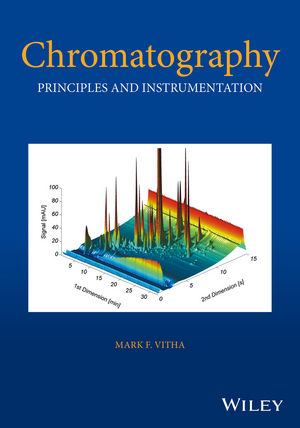
Chromatography
John Wiley & Sons Inc (Verlag)
978-1-119-27088-1 (ISBN)
Highlights the primary variables that practitioners can manipulate, and how those variables influence chromatographic separations
Includes multiple figures that illustrate the application of these methods to actual, complex chemical samples
Problems are embedded throughout the chapters as well as at the end of each chapter so that students can check their understanding before continuing on to new sections
Each section includes numerous headings and subheadings, making it easy for faculty and students to refer to and use the information within each chapter selectively
The focused, concise nature makes it useful for a modular approach to analytical chemistry courses
Mark F. Vitha is currently a Professor at Drake University. He received his Ph.D. from the University of Minnesota. He is the series editor for The Chemical Analysis Series (Wiley) and is a co-editor of the book High Throughput Analysis for Food Safety (Wiley, 2014). He has been named as a Levitt Teacher of the Year, a Windsor Professor of Science, and a Ronald D. Troyer Research Fellow at Drake.
Preface ix
1. Fundamentals of Chromatography 1
1.1 Theory 1
1.1.1 Component Separation 3
1.1.2 Retention Factor 6
1.1.3 Separation 11
1.1.4 Resolution and Theoretical Plates 13
1.2 Band Broadening 20
1.2.1 Diffusion 21
1.2.2 Linear Velocity 23
1.2.3 Broadening in Open Tubes with No Stationary Phase and No Retention 24
1.2.4 Broadening in Open Tubes with a Stationary Phase 28
1.2.5 Broadening in a Packed Column 34
1.2.6 Putting It All Together 43
1.2.7 Practical Consequences of Broadening Theory 45
1.3 General Resolution Equation 47
1.4 Peak Symmetry 51
1.5 Key Operating Variables 51
1.6 Instrumentation 53
1.7 Practice of The Technique 53
1.7.1 Quantitation 53
1.7.2 Internal Standards and the Method of Standard Additions 55
1.8 Emerging Trends and Applications 55
1.9 Summary 55
Problems 56
References 59
Further Reading 59
2. Gas Chromatography 61
2.1 Theory of Gas Chromatographic Separations 61
2.1.1 GC Columns and Partitioning 64
2.2 Key Operating Variables that Control Retention 64
2.2.1 Adjusting Retention Time: Temperature 65
2.2.2 Adjusting Retention Time: Temperature Programming 67
2.2.3 Adjusting Retention Time: Mobile Phase Flow Rate 69
2.2.4 Adjusting Retention Time: The Column and the Stationary Phase 72
2.2.5 Adjusting Retention Time: Summary 78
2.2.6 Measures of Retention 78
2.3 Gas Chromatography Instrumentation 82
2.3.1 Carrier Gas Supply 83
2.3.2 The Injection Port and the Solute Injection Process 83
2.3.3 Oven/Column Compartment 97
2.3.4 Detectors 98
2.4 A More Detailed Look at Stationary Phase Chemistry: Kovats Indices and Mcreynolds Constants 111
2.4.1 Kovats Retention Indices 111
2.4.2 Stationary Phase Selection 120
2.5 Gas Chromatography in Practice 124
2.5.1 Syringe Washing 124
2.5.2 Controls and Blanks/Ghost Peaks 124
2.5.3 Autosamplers 125
2.5.4 GC Septa 125
2.5.5 Qualitative Analysis 126
2.5.6 Quantitative Analysis 126
2.5.7 Derivatization 128
2.5.8 High-Speed GC 128
2.5.9 Tandem GC 129
2.5.10 Microfabricated GC 129
2.6 A “Real-World” Application of Gas Chromatography 131
2.6.1 GC and International Oil Trading 131
2.7 Summary 136
Problems 137
References 143
Further Reading 144
3. Liquid Chromatography 145
3.1 Examples of Liquid Chromatography Analyses 145
3.2 Scope of Liquid Chromatography 147
3.3 History of LC 148
3.3.1 Modern Packing Materials 149
3.4 Modes of Liquid Chromatography 152
3.4.1 Normal Phase Liquid Chromatography (NPLC) 152
3.4.2 Reversed-Phase Liquid Chromatography (RPLC) 154
3.4.3 Ion-Exchange Chromatography (IEX) 165
3.4.4 Hydrophilic Interaction Chromatography (HILIC) 173
3.4.5 Size Exclusion Chromatography (SEC) 175
3.4.6 Affinity Chromatography 178
3.5 HPLC Instrumentation 180
3.5.1 The Proportioning Valve 181
3.5.2 Mixing Chamber 181
3.5.3 Pumps 181
3.5.4 Injection 183
3.5.5 The Column and Particles 185
3.5.6 Guard Columns 187
3.5.7 Detectors 188
3.6 Specific Uses of and Advances in Liquid Chromatography 201
3.6.1 Chiral Separations 202
3.6.2 Preparative-Scale Chromatography 207
3.6.3 Ultra-High Performance Liquid Chromatography (UHPLC) for High-Speed Separations 212
3.6.4 Tandem-Column Liquid Chromatography 216
3.6.5 Two-Dimensional Liquid Chromatography (2D-LC) 218
3.7 Application of LC – Analysis of Pharmaceutical Compounds in Groundwater 224
3.7.1 Sampling 225
3.7.2 Analysis Method for 21 Antibiotics – Sample Pretreatment 225
3.7.3 Use of Internal Standards and Other Quality Assurance Issues 227
3.7.4 LC Analyses 228
3.7.5 Mass Spectrometric Selected Ion Monitoring Detection 228
3.7.6 Results 229
3.8 Summary 230
Problems 230
References 232
Solutions 237
Index 263
| Erscheinungsdatum | 26.10.2016 |
|---|---|
| Verlagsort | New York |
| Sprache | englisch |
| Maße | 142 x 252 mm |
| Gewicht | 658 g |
| Themenwelt | Naturwissenschaften ► Biologie |
| Naturwissenschaften ► Chemie ► Analytische Chemie | |
| Technik | |
| ISBN-10 | 1-119-27088-X / 111927088X |
| ISBN-13 | 978-1-119-27088-1 / 9781119270881 |
| Zustand | Neuware |
| Haben Sie eine Frage zum Produkt? |
aus dem Bereich


